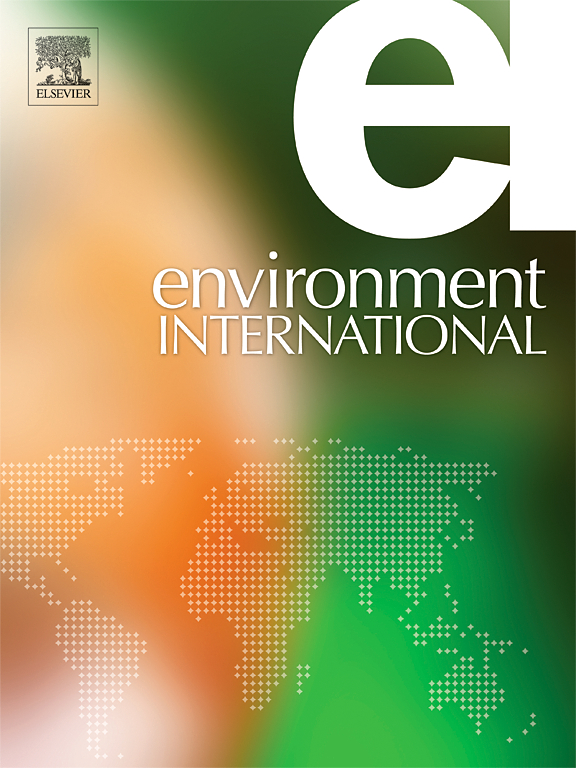通过结合数据同化和基于深度学习的偏差校正改进 WRF-Chem PM2.5 预测
IF 9.7
1区 环境科学与生态学
Q1 ENVIRONMENTAL SCIENCES
引用次数: 0
摘要
在数值模式模拟中,初始条件数据同化(DA)和模式输出偏差校正(BC)已被证明是改进 PM2.5(空气动力学当量直径≤ 2.5 μm 的颗粒物)预测的有效方法。本研究比较了这两种方法的优化效果,并开发了一种同时结合DA和BC的新方案。在2019年冬季进行了四次平行实验:由WRF-Chem直接预报的对照实验(实验名称:WRF-Chem);基于GSI(网格点统计插值)系统同化原地观测数据的实验(WRF-Chem_DA);基于深度学习的BC实验(WRF-Chem_BC);以及考虑初始条件DA和BC相结合的实验(WRF-Chem_DA_BC)。据统计,在最初的24 h内,DA和BC都能优化PM2.5的预测精度,WRF-Chem_BC在初始场的表现优于WRF-Chem_DA,尤其是在10-24 h内,而BC和DA的组合则达到了最佳表现。在最初的 24 小时内,与对照实验相比,WRF-Chem_DA_BC(WRF-Chem_DA、WRF-Chem_BC)的结果在均方根误差方面有所改善,减小比例从 38.90 % 到 48.86 % 不等(18.88 % 到 32.44 %,30.10 % 到 46.08 %)。除全域优化效果最佳外,该组合方法在不同区域也有良好表现:在 0-24 h 预报期内,京津冀、长三角、华中和四川盆地城市群的均方根误差分别从 32 % 降至 62 %、39 % 降至 57 %、28 % 降至 40 % 和 30 % 降至 49 %。本文章由计算机程序翻译,如有差异,请以英文原文为准。
Improving WRF-Chem PM2.5 predictions by combining data assimilation and deep-learning-based bias correction
In numerical model simulations, data assimilation (DA) on the initial conditions and bias correction (BC) of model outputs have been proven to be promising approaches to improving PM2.5 (particulate matter with an aerodynamic equivalent diameter of ≤ 2.5 μm) predictions. This study compared the optimization effects of these two methods and developed a new scheme that combines DA and BC simultaneously. Four parallel experiments were conducted during winter 2019: a control experiment directly forecasted by WRF-Chem (experiment name: WRF-Chem); an experiment that assimilated in situ observations based on the GSI (Gridpoint Statistical Interpolation) system (WRF-Chem_DA); an experiment with deep-learning-based BC (WRF-Chem_BC); and an experiment considering the combination of DA on the initial conditions and BC (WRF-Chem_DA_BC). Statistically, the accuracy of PM2.5 predictions could be optimized by both DA and BC for the first 24-h period, and WRF-Chem_BC performed better than WRF-Chem_DA in the initial field, especially in the period of 10–24 h, while the best performance was achieved by combining BC and DA. Throughout the initial 24-h period, compared with the control experiment, the results of WRF-Chem_DA_BC (WRF-Chem_DA, WRF-Chem_BC) showed an improvement in terms of root-mean-square error, with reduction proportions varying from 38.90 % to 48.86 % (18.88 % to 32.44 %, 30.10 % to 46.08 %). Besides having the best optimization effect over the whole domain, the combined method also performed well in different regions: during the forecasting period of 0–24 h, the RMSEs decreased from 32 % to 62 %, 39 % to 57 %, 28 % to 40 %, and 30 % to 49 % in the Beijing–Tianjin–Hebei, Yangtze River Delta, Central China, and Sichuan Basin urban agglomerations, respectively.
求助全文
通过发布文献求助,成功后即可免费获取论文全文。
去求助
来源期刊

Environment International
环境科学-环境科学
CiteScore
21.90
自引率
3.40%
发文量
734
审稿时长
2.8 months
期刊介绍:
Environmental Health publishes manuscripts focusing on critical aspects of environmental and occupational medicine, including studies in toxicology and epidemiology, to illuminate the human health implications of exposure to environmental hazards. The journal adopts an open-access model and practices open peer review.
It caters to scientists and practitioners across all environmental science domains, directly or indirectly impacting human health and well-being. With a commitment to enhancing the prevention of environmentally-related health risks, Environmental Health serves as a public health journal for the community and scientists engaged in matters of public health significance concerning the environment.
 求助内容:
求助内容: 应助结果提醒方式:
应助结果提醒方式:


